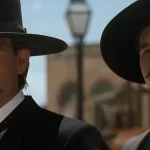Home Video Hovel: Nightmares, by David Bax
Given that both content providers and consumers in America don’t seem to make much space for short form cinema, the anthology film is one of the few and best ways to experience movies that are pithy and succinct, traits not highly valued in the mainstream if superhero movie run times are any indication. The horror genre has long been particularly accommodating of anthologies, from Tales of Terror to Creepshow all the way up to more recent fare like the V/H/S and The ABCs of Death franchises. Joseph Sargent’s 1983 entry in the subgenre, Nightmares, now available on Blu-ray from Shout! Factory, is not the best known but it’s representative of short films in general in that it’s a grab bag of varying quality but with a couple bits worth the price of admission.
These four films, all directed by Sargent (The Taking of Pelham One Two Three), were originally produced for a television anthology series that never came to be (and not, as many internet sources will have you believe, for ABC’s short-lived Darkroom series). And so Nightmares came together as a movie out of necessity. As a result, there isn’t much on hand to unify these four stories. The first couple flirt with addressing different kinds of addiction (cigarettes, arcade games) but that doesn’t pan out in the back half. And a couple of the sections hint at “It was all a dream” conclusions, which would at least correlate with the movie’s title. Thankfully, though, none of them ends up taking that copout route.
So what you’ve got is two sets of two movies each, your hits and your misses. Let’s start with the good stuff. The second chapter, “The Bishop of Battle,” stars Emilio Estevez, in a role that presages his work in Repo Man a year later, as a sort of punk rock arcade brat. Cranking up songs by Fear on his Walkman, he becomes intensely obsessed with a game called The Bishop of Battle, to the point of alienating his friends and family. Not able to stand being away from it, he breaks into the arcade one night to try to best his high score. Things get freaky. Estevez is at the top of his talents in a committedly angry and manic performance.
The third movie, “The Benediction,” is a nifty little thriller that’s essentially a supernatural twist on Steven Spielberg’s Duel. Instead of a milquetoast businessman, Lance Henriksen stars as a disillusioned priest terrorized on the highway by a pick-up truck the film heavily suggests is driven by the devil himself. The action and effects are taut and Henriksen provides just enough pathos to keep it from being pure homage.
Now on to the less than good stuff. Nightmares starts with a slight story about a woman (Christina Raines) who has the misfortune of running out of cigarettes at the same time as a homicidal escaped mental patient (Lee Ving from the aforementioned Fear) is stalking the San Fernando Valley in “Terror in Topanga.” This entry is not so much bad as it is inconsequential and anticlimactic. Raines is solid, though, and does good by all of us smokers.
Sargent saves the worst for last. “Night of the Rat” is both the dumbest and the longest (or at least it feels like it) of the four stories. Claire (Veronica Cartwright) is worried that her house is infested with rats. Her husband (Richard Masur, doing a very good job playing an arrogant, sexist piece of shit) doesn’t take her seriously, insisting that it’s no big deal and that he can take care of it himself. Eventually, though, Claire caves and calls an exterminator (Albert Hague) who is familiar with medieval German folklore, as all exterminators must be. He tells her that she’s dealing with a mythical, evil, giant rat monster that can’t be killed. Most of the climax features Masur stalking around their suburban, colonial home with a shotgun while Cartwright repeatedly screams, “You can’t kill it!” Just like the cartridges he keeps loading, the whole thing is a waste of time.
Overall, though, Nightmares is worth a watch. The good ones are good, all four are pretty short and the worst one is at the end, where you can just skip it.
The Blu-ray looks mostly good, though the film has an overall flatness that more likely reflects its television origins than the transfer.
Special features include both the 1.78 and 1.33 options, an audio commentary with Raines and producer Andrew Mirisch and the theatrical trailer.


























